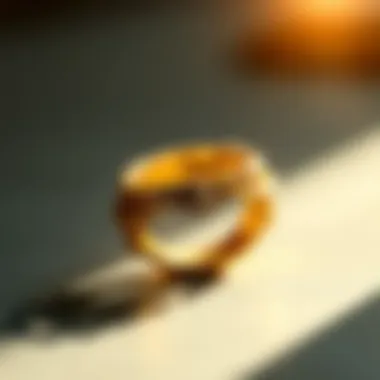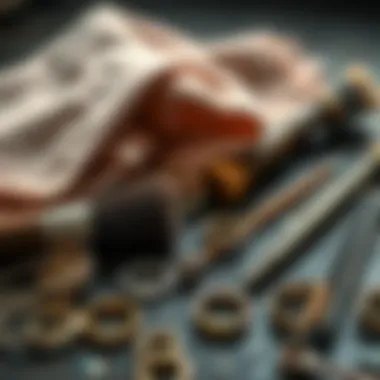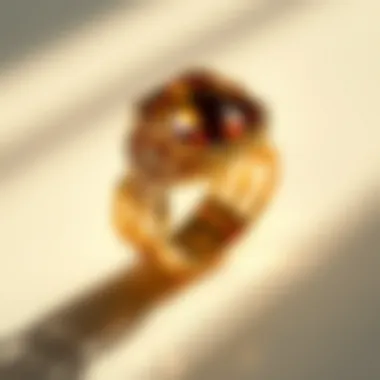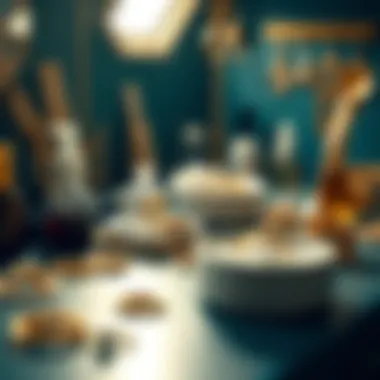Mastering the Art of Polishing Gold Rings


Intro
Gold rings are more than just pieces of jewelry; they carry stories, memories, and sometimes even a touch of magic. Whether it’s a simple band or an ornate piece adorned with precious stones, maintaining their shine and integrity is essential for any jewelry lover or professional in the field. With the right techniques, you can ensure that your gold rings not only sparkle like the day you received them but also endure the test of time.
In this article, we’ll embark on a comprehensive journey through the techniques of polishing gold rings. It’s not merely about restoring shine; it’s about doing so while preserving every intricate detail and ensuring that the piece remains as captivating as ever. We will explore various methodologies, tools, and aftercare practices that can contribute to the longevity of your cherished rings.
Now let's dive into the details, starting with the characteristics of gold rings that make them unique.
Understanding Gold Rings
When it comes to jewelry, gold rings hold a significant place in both culture and personal expression. Understanding the particulars of gold rings serves as the foundation for effective polishing techniques. A gold ring is not just a piece of adornment; it often embodies emotions, heritage, or milestones in life. As such, knowing its composition, alloy types, and common designs can influence how one cares for and maintains these treasures.
Composition of Gold Varieties
Gold in its pure form is too soft for practical use in jewelry, which is where the concept of gold alloys comes into play. Standard gold jewelry is typically composed of a mixture of gold and other metals, enhancing durability while maintaining that sought-after luster. The purity of gold is measured in karats, with 24 karat being pure gold. Common alloys include:
- 18 karat (75% gold) mixes well with copper and silver, yielding a rich tone.
- 14 karat (58.3% gold) is often favored for its balance between durability and beauty.
- 10 karat (41.7% gold) is more resistant to scratching, making it suitable for daily wear.
For important care practices, recognizing the type of gold alloy helps in selecting suitable polishing tools and compounds. Each alloy may respond differently to certain cleaning methods or products, making this knowledge crucial for maintaining the aesthetic appeal.
Identifying Different Gold Alloys
Understanding the different alloys can feel like trying to decode a language; however, it's essential for anyone looking to keep their gold rings in tip-top shape. The appearance, wear and tear, and even the polishing method can vary quite a bit depending on whether a ring is made of white gold, yellow gold, or rose gold.
- Yellow Gold: Classic and timeless, yellow gold has a warm glow, often mixed with copper and silver.
- White Gold: Often plated with rhodium, white gold provides a cooler look reminiscent of platinum. Over time, this plating may wear off, requiring specific polishing techniques to rejuvenate its shine.
- Rose Gold: Gaining in popularity, rose gold is alloyed with a higher percentage of copper, giving it a distinct reddish hue. Its softness can require gentler polishing techniques to prevent damage.
Knowing what your ring is made from will guide you on the best ways to both clean and polish it, ensuring you preserve its integrity.
Common Designs and Settings
The aesthetic aspect of gold rings transcends beyond the glittering surface. The design and settings of the rings contribute significantly to how light interacts with them, affecting their overall shine and visual appeal. Some popular design aspects include:
- Solitaire: A classic design featuring a single stone, which allows for straightforward polishing since the focus is mainly on the gold band.
- Halo: A style where smaller stones surround a central one, creating a dazzling effect; however, care needs to be taken to ensure polishing does not affect the smaller stones.
- Channel-set Stones: These are embedded within the band, which could make polishing tricky because you must be cautious not to scratch the stones.
Understanding these designs helps one approach polishing with a tailored plan, considering the settings and types of stones involved.
"Gold rings are not merely ornaments; they are artifacts of sentiment and history, deserving meticulous care and attention."
In summary, the comprehension of gold rings—in terms of their composition, alloy types, and designs—plays a key role in effective polishing. This foundational knowledge allows jewelry enthusiasts and collectors to maintain that radiant gleam, reinforcing the timeless allure of gold.
Why Polish Gold Rings?
Polishing gold rings goes beyond simply restoring their shine. It’s an essential practice that helps maintain their beauty and structural integrity over time. This section unfolds two key aspects driving the necessity to polish gold rings: the desire to keep them looking their best and the practical benefits that arise from a routine polishing regimen.
Maintaining Aesthetic Appeal
Gold rings, with their warm luster and timeless shine, often serve as focal points in jewelry collections. Whether inherited from a family member, a cherished gift, or a personal indulgence, these rings hold significant emotional value. Over time, however, exposure to everyday elements—such as hand lotions, dirt, and even air—can dull their surface and make them look lackluster.
To ensure that the gleam of gold rings remains vibrant, routine polishing is essential. The right techniques can accentuate their beauty and enhance the appeal of any ornate designs or gemstones that may be set within the ring itself. Moreover, a well-maintained gold ring often becomes a conversation starter.
"A polished ring not only shines brighter but speaks volumes about the care taken by its owner."


Regular polishing allows you to appreciate the craftsmanship and artistry involved in creating the piece. When light catches the polished surface, the reflections add a dazzling effect that might otherwise be lost in tarnish.
Preventing Damage and Wear
Gold is a precious metal; however, it is not impervious to wear and tear. The accumulation of grime, tarnish, and even scratches can weaken the metal and obscure its beauty. By polishing gold rings, you actively combat the effects of daily wear, helping preserve the underlying metal.
Consider the following when thinking about the importance of polishing:
- Tarnish Removal: Gold may develop a tarnish due to oxidation or chemical reactions with other substances. Regular polishing removes these harmful residues.
- Scratch Prevention: A smooth surface is less likely to accumulate scratches and pollutants. Polishing maintains this uniformity, reducing the chances of deeper damage.
- Structural Integrity: Gold rings, especially those designed with intricate settings and stones, face potential risks of damage if neglected. Polishing helps to identify early signs of wear, allowing for repairs to be made before they escalate.
In summary, polishing gold rings serves both to maintain their aesthetic beauty and protect the integrity of the piece. Making polishing a regular practice can ensure that the rings not only look stunning but also remain a vital part of your jewelry collection for years to come.
Essential Tools for Polishing Gold
Having the right tools is half the battle won when it comes to polishing gold rings. The quality of your tools can make a noticeable difference in the final outcome of your efforts. Good equipment not only enhances the shine of the gold but also ensures the longevity of the piece, so you're not doing more harm than good.
Polishing Cloths and Buffing Compounds
When it comes to polishing, polishing cloths and buffing compounds are your best friends. A quality polishing cloth, usually made of microfiber or flannel, plays a significant role in removing scratches and restoring luster. These cloths are specially treated with abrasives that gently buff the gold without scratching it. A simple rub down with a soft cloth can bring that golden glow back to life, especially for rings that are regularly worn.
On the other hand, buffing compounds come in various grades, ranging from coarse to super fine. The trick lies in choosing the right compound based on how much you need to polish. For instance, if there's significant tarnishing, you might start with a coarser compound, then work your way to finer ones for that showroom shine.
"Investing in quality polishing cloths and buffing compounds is crucial for maintaining your jewelry's appeal."
Ultrasonic Cleaners Explained
Ultrasonic cleaners are another essential tool, particularly for those handling intricate designs. These devices use high-frequency sound waves to agitate a fluid, typically water mixed with a cleaning solution, creating microscopic bubbles. When these bubbles implode, they create tiny shock waves that dislodge dirt and grime. This technology is especially effective in cleaning hard-to-reach areas of a ring, such as behind gemstones or in intricate settings.
However, caution is key here. Not every type of gold ring is suitable for ultrasonic cleaning. For example, softer stones or delicate settings can be damaged in an ultrasonic bath. Always double-check the suitability of your rings before committing to this cleaning method.
Hand Tools vs. Power Tools
The choice between hand tools and power tools often stems from personal preference and the specific needs of the task. Hand tools, like a simple buffing wheel attached to a Dremel, offer precision and control. They allow the jeweler to focus on particular areas of the ring that need attention. Plus, hand polishing can feel more satisfying, like an artisan craft.
In contrast, power tools save time and are highly effective for heavier tarnish or larger surfaces. For instance, a power polisher with wax or polishing pads can quickly remove oxidation and provide a brilliant finish. Just be cautious with the speed settings, as too high can lead to heat build-up, possibly damaging the gold.
When weighing your options, consider the following:
- Project Size: Larger rings or pieces require more power, while delicate rings benefit from hand polishing.
- Experience Level: If you’re just starting, hand tools allow for more gentle and controlled polishing.
- Investments: Quality hand tools can often be less expensive than power tools, making them more accessible for beginners.
In sum, equipping yourself with the right tools will not only streamline the polishing process but also enhance the overall aesthetic of your gold rings. Taking time to understand each tool’s nuances ensures your gold jewelry retains its elegance for years to come.
Preparatory Steps Before Polishing
Before embarking on the journey of polishing your gold rings, it’s crucial to take the necessary preparatory steps. These initial actions not only ensure the safety of your jewelry but also maximize the effectiveness of your polishing efforts. The importance of these steps cannot be overstated, as they set the stage for the results you wish to achieve and help maintain the brilliance of your precious pieces.
Inspection for Damage
Before any polishing takes place, inspect your gold rings for signs of wear and tear. Look closely for scratches, dents, or any loose stones. If there’s any visible wear, polishing might exacerbate the issue instead of remedying it. For instance, a ring with a loose diamond or gemstone should ideally be repaired before polishing to avoid further damage. Noticing these details can save you from unexpected costly repairs down the line. In some cases, certain types of damage may necessitate professional assessment to ensure the longevity of your ring.
Choosing the Right Method


Once you’ve completed your inspection, the next step is to determine the appropriate polishing method. There’s no one-size-fits-all approach when it comes to polishing gold rings; your chosen technique should align with the specific needs of the ring itself. For instance, a simple, solid gold band can generally be polished with a cloth and some polishing compound, while a ring with intricate designs may require a different approach to avoid losing details.
- Polishing Cloth: Ideal for routine maintenance, a polishing cloth can gently remove surface tarnish without removing any material from the ring itself.
- Buffing Wheel: A buffing wheel can restore shine but should be used with caution, primarily on sturdier settings.
- Ultrasonic Cleaners: If your ring has intricate settings, an ultrasonic cleaner may be the best option. It uses sound waves and cleaning solution to gently remove dirt without intensive physical abrasion.
Selecting the appropriate method enhances not only the polish but also the safety and integrity of your gold.
Cleaning the Ring
Even before actual polishing begins, cleaning the ring is an absolute must. Dust, oils, and grime can become embedded in the surface, hindering the polishing process. Using a gentle soap and water solution, wash the ring thoroughly. A soft toothbrush can help reach crevices where dirt may be lurking, specially around settings.
After cleaning, dry the ring using a lint-free cloth, making sure it is completely dry before proceeding to the polishing phase.
"Preparation is the key to any successful endeavor. In the case of polishing your gold rings, it’s the difference between mere shine and a brilliant glow."
Taking these preparatory steps seriously gives you a solid foundation for the polishing process. With a careful inspection completed, the right polishing method selected, and the rings cleaned, you are well on your way to restoring their former glory.
Step-by-Step Polishing Process
Polishing gold rings is not just about getting them to shine; it’s a process that requires careful attention to detail and an understanding of the materials you are working with. By familiarizing yourself with effective techniques, you can restore the luster of your gold jewelry while ensuring its longevity. This guide highlights several methods that can be beneficial in the polishing process, giving your rings that eye-catching gleam again.
Using a Polishing Cloth
When it comes to polishing gold rings, a polishing cloth is one of the most straightforward and effective tools you can use. These cloths are often treated with a special polishing compound designed specifically for metals, making it easier to remove grime and restore shine.
- Select the Right Cloth: It is vital to choose a cloth that is soft and non-abrasive. This will prevent scratching while allowing you to clean without much hassle.
- Technique Matters:
- Final Touches: After polishing, take a moment to inspect your results. Hold the ring up to the light to make sure every angle catches the shine you desire.
- Gently rub the ring in a circular motion. This method helps eliminate any surface dirt without causing any damage to the metal.
- Focus on areas that seem dull or scratched, applying a bit more pressure on those spots, but not too much to avoid wear on the metal.
Buffing with Compounds
Once the preliminary cleaning is done, you might want to raise that luster even further using buffing compounds. Buffing compounds are an excellent way to give your gold ring that showroom shine, but you must handle these with care.
- Choosing a Compound: Not all compounds are created equal. Look for a suitable gold-specific buffing compound to avoid any adverse reactions with your ring.
- Applying the Compound:
- Clean Up: After buffing, it’s important to wipe off any residue from the compound. This ensures your ring doesn’t just look shiny but is also free from any unwanted materials that could tarnish it in the future.
- Use a buffing wheel or a soft cloth. If you opt for a wheel, ensure it’s compatible with your drill or buffing machine.
- Apply a small amount of compound to the cloth or wheel, and begin buffing in gentle, smooth motions. Too much pressure can lead to overheating, which can compromise the gold’s integrity.
- Keep the surface airy and avoid prolonged contact with one area to prevent any gum from forming.
Handling Intricate Designs
Gold rings featuring intricate designs present their own set of challenges during the polishing process. These unique features can trap dirt and make thorough cleaning a little trickier.
- Gentle Approach:
- Diverse Techniques: Depending on the complexity of the design, consider different polishing strategies:
- When polishing rings with detailed engravings or settings, be sure to use extra caution. An overly aggressive polish can wear away fine details or even bend delicate prongs holding stones in place.
- Use a soft toothbrush or a small, soft-bristle brush dipped in a cleaning solution for the most delicate areas. This can help you clean hard-to-reach spots without damaging the design.
- For simple motifs or engravings, using a polishing cloth might suffice.
- For more elaborate designs, employing a combination of a polishing cloth and a compound will yield the best results, allowing you to maintain both shine and detail.
Ultimately, patience is key in polishing gold rings, especially intricate designs. Each step, no matter how small, contributes to preserving the ring's beauty and structural integrity.
Tip: Always ensure to regularly assess the condition of your jewelry to determine the right polishing method to apply. Small, consistent care practices go a long way in extending the life of your cherished gold rings.
Aftercare Tips


Taking care of your gold rings doesn’t end once they’re polished and shining. In fact, the aftercare is just as important. It keeps your jewels looking pristine, preserving their luster over time. Having a regular routine and smart storage can go a long way in ensuring that your gold rings look as good as new, day after day.
Regular Maintenance Routines
To keep your gold rings in tip-top shape, establishing a maintenance routine is crucial. Regular care doesn’t have to be burdensome; it can be simple enough to weave into your daily life.
An effective maintenance routine includes:
- Cleaning: Regular cleaning removes dirt and oils that accumulate from daily wear. Use a soft, lint-free cloth to gently wipe your rings after each wear; this can help prevent any build-up and keep them shining bright.
- Periodic Polishing: Depending on the frequency of wear, consider polishing your rings about once every few months. It can be as simple as using a polishing cloth specifically designed for gold. This helps maintain the ring's shine without overdoing it.
- Inspection: Get into the habit of checking your rings for any signs of wear and tear. Look for loose stones or scratches; catching these issues early can save a lot of trouble later on.
By implementing these maintenance steps, you can significantly prolong the lifespan of your gold rings while preserving their exquisite beauty.
Storage Practices for Gold Rings
Ah, the age-old question of how to store jewelry. Proper storage not only keeps your gold rings safe but also helps prevent scratches and tarnishing. If you think tossing them in a drawer or on a tabletop is fine, think again.
Here are some tips for effectively storing your gold rings:
- Jewelry Boxes: Invest in a good-quality jewelry box with soft lining. This provides a protective home for your rings and prevents them from scratching against one another.
- Separate Compartments: If your jewelry box has multiple compartments, make sure to use them. Storing each ring separately can avoid scratches that happen when rings rub against each other.
- Avoid Humidity: Keep your jewelry in a dry, cool place. Humidity can lead to tarnishing, so it’s advisable to avoid leaving your rings in bathrooms or other damp areas.
- Use Anti-Tarnish Pouches: For those who want to take it a step further, consider using anti-tarnish pouches or cloths. These can help keep your rings pristine by preventing oxidation.
"A little prevention goes a long way when it comes to maintaining your gold rings."
With proper aftercare, your gold rings won’t just remain beautiful for years, but they’ll also hold sentimental value, reflecting the time and care you invested in them.
Frequently Asked Questions about Gold Ring Polishing
Gold rings often hold significant emotional and financial value. It’s common for enthusiasts, collectors, and designers to have queries about maintaining their shine and integrity. In this section, we will delve into common questions related to polishing gold rings, addressing concerns that frequently arise.
How Often Should You Polish Gold?
The frequency of polishing gold rings can depend on several factors. Generally, it’s advisable to polish gold rings once every few months, depending on how often the ring is worn. Factors that influence this include:
- Usage: Rings worn daily may tarnish quicker than those stored for special occasions.
- Environment: Exposure to saltwater, chlorine, and household chemicals can accelerate wear.
- Personal Preference: Some individuals prefer a consistently polished appearance, while others may not mind a bit of tarnish.
Over-polishing can lead to the removal of metal, so it's wise to assess the condition of your ring regularly. A gentle cleaning in between polishings, using a soft cloth, can help maintain its appearance without the need for constant professional assistance.
Is Professional Polishing Necessary?
While many can polish their gold rings at home, professional polishing has its place. Here are points to consider:
- Expertise: Jewelers have the experience to detect damage and choose appropriate polishing methods that prevent further issues.
- Equipment: Professionals use specialized tools such as ultrasonic cleaners and polishing machines that produce a more uniform shine.
- Care for Intricate Designs: If your ring features delicate engravings or settings, a professional might be better equipped to handle these intricacies without causing damage.
In most cases, a combination of home care and occasional professional services works best. Regular cleaning at home and scheduling professional polishing every couple of years or when the rings show significant wear can keep them looking pristine.
Regular care is your best ally in maintaining the brilliance of your gold ring. Remember, sometimes less is more when it comes to polishing.
For more insights on jewelry care, check resources like Wikipedia or forums such as Reddit to engage with other enthusiasts and professionals.
Epilogue
Polishing gold rings is not merely a task of enhancing their visual appeal; it’s a vital practice that carries benefits beyond the surface shine. Maintaining the luster of these precious pieces contributes significantly to their longevity and overall value. By employing informed polishing techniques, enthusiasts can protect the integrity of their rings, ensuring that they withstand the test of time. The knowledge shared throughout this article serves to equip both amateur and seasoned jewelry aficionados with the insights necessary to keep their gold rings in prime condition.
Summary of Key Points
- Understanding Composition: Recognizing the different types of gold—like 10k, 14k, and 24k is essential for selecting appropriate polishing methods that do not compromise the metal’s structure.
- Polishing Tools: Using the right tools, including polishing cloths and buffing compounds, significantly impacts the outcome. Choosing incorrect tools can result in scratches and diminished shine.
- Inspection Before Polishing: Evaluating the condition of gold rings prior to polishing helps prevent accidental damage, such as polishing over scratches or loose settings.
- Aftercare Practices: Implementing routine maintenance and proper storage practices is crucial for preserving the longevity and aesthetics of gold rings.
- Professional Help: While DIY polishing methods are valuable, knowing when to seek expert assistance can safeguard against unintentional damage.
Final Thoughts on Gold Ring Care
Taking care of gold rings goes hand in hand with knowing their unique characteristics, designs, and potential wear factors. It's not enough to simply polish them once or twice a year; this care should be a regular part of one’s jewelry routine. The information presented throughout this article underscores the importance of vigilance in maintaining the beauty and value of gold rings. Investing time into understanding how to properly polish and maintain these pieces pays dividends in both their appearance and their historical and sentimental value. Being proactive in care means these treasures can be passed down through generations, retaining both meaning and shimmer.







